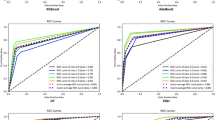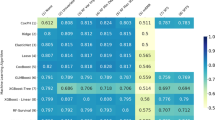Abstract
Survival prediction is an important problem that is encountered widely in industry and medicine. Despite the explosion of artificial intelligence technologies, no uniformed method allows the application of any type of regression learning algorithm to a survival prediction problem. Here, we present a statistical modeling method that is generalized to all types of regression learning algorithm, including deep learning. We present its empirical advantage when it is applied to traditional survival problems. We demonstrate its expanded applications in different types of regression learning algorithm, such as gradient boosted trees, convolutional neural networks and recurrent neural networks. Additionally, we demonstrate its application in clinical informatic data, pathological images and the hardware industry. We expect that this algorithm will be widely applicable for diverse types of survival data, including discrete data types and those suitable for deep learning such as those with time or spatial continuity.
This is a preview of subscription content, access via your institution
Access options
Access Nature and 54 other Nature Portfolio journals
Get Nature+, our best-value online-access subscription
$29.99 / 30 days
cancel any time
Subscribe to this journal
Receive 12 digital issues and online access to articles
$99.00 per year
only $8.25 per issue
Buy this article
- Purchase on Springer Link
- Instant access to full article PDF
Prices may be subject to local taxes which are calculated during checkout




Similar content being viewed by others
Data availability
Simulated data are available at from GitHub (https://github.com/GuanLab/GuanRank_All). TCGA data15 are third party and downloadable from their websites using the Genomic Data Commons (GDC) Data Portal19. Backblaze disk failure data are third party and downloadable from the Backblaze harddrive data and stats website16. Source data are available with this paper.
Code availability
Source code is available at https://github.com/GuanLab/GuanRank_All (ref. 20). No restriction is placed on access.
References
Cox, D. R. Regression models and life-tables. J. R. Stat. Soc. B 34, 187–202 (1972).
Ishwaran, H. The effect of splitting on random forests. Mach. Learn. 99, 75–118 (2015).
Ishwaran, H., Kogalur, U. B., Blackstone, E. H. & Lauer, M. S. Random survival forests. Ann. Appl. Stat. 2, 841–860 (2008).
Ishwaran, H., Kogalur, U. B., Chen, X. & Minn, A. J. Random survival forests for high-dimensional data. Stat. Anal. Data Min. 4, 115–132 (2011).
Kalbfleisch, J. D. & Prentice, R. L. in The Statistical Analysis of Failure Time Data 328–374 (Wiley, 2011); https://doi.org/10.1002/9781118032985.ch11
Wei, L. J. The accelerated failure time model: a useful alternative to the Cox regression model in survival analysis. Stat. Med. 11, 1871–1879 (1992).
Aitkin, M. & Clayton, D. The fitting of exponential, Weibull and extreme value distributions to complex censored survival data using GLIM. J. R. Stat. Soc. C 29, 156–163 (1980).
Lee, C., Yoon, J. & van der Schaar, M. Dynamic-DeepHit: a deep learning approach for dynamic survival analysis with competing risks based on longitudinal data. IEEE Trans. Biomed. Eng. 67, 122–133 (2020).
Quirós, A., de Prado, A. P., Montoya, N. & Hernández, J. Multi-state models for the analysis of survival studies in biomedical research: an alternative to composite endpoints. In Proc. 13th International Joint Conference on Biomedical Engineering Systems and Technologies (eds De Maria, E. et al.) 194-199 (BIOSTEC, 2020); https://doi.org/10.5220/0009105701940199
Cui, L. et al. A deep learning-based framework for lung cancer survival analysis with biomarker interpretation. BMC Bioinf. 21, 1–14 (2020).
Ren, J., Singer, E. A., Sadimin, E., Foran, D. J. & Qi, X. Statistical analysis of survival models using feature quantification on prostate cancer histopathological images. J. Pathol. Inform. 10, 30 (2019).
Li, H. et al. Deep convolutional neural networks for imaging data based survival analysis of rectal cancer. Proc. IEEE Int. Symp. Biomed. Imaging 2019, 846–849 (2019).
Ching, T., Zhu, X. & Garmire, L. X. Cox-nnet: an artificial neural network method for prognosis prediction of high-throughput omics data. PLoS Comput. Biol. 14, e1006076 (2018).
Harden, J. J. & Kropko, J. Simulating duration data for the Cox model. Political Sci. Res. Methods 7, 921–928 (2019).
Weinstein, J. N. et al. The Cancer Genome Atlas Pan-Cancer analysis project. Nat. Genet. 45, 1113–1120 (2013).
Backblaze. Hard Drive Data and Stats 2013–2015; https://www.backblaze.com/b2/hard-drive-test-data.html
Schuster, M. & Paliwal, K. K. Bidirectional recurrent neural networks. IEEE Trans. Signal Process. 45, 2673–2681 (1997).
Swindell, W. R. Accelerated failure time models provide a useful statistical framework for aging research. Exp. Gerontol. 44, 190–200 (2009).
National Cancer Institute. Genomic Data Commons Data Portal; https://portal.gdc.cancer.gov/
Guan, Y. GuanRank code (version 1.0.0) (Zenodo, 2021); https://doi.org/10.5281/zenodo.4751702
Acknowledgements
Y.G. is supported by the NIH (R35-GM133346) and the NSF (#1452656).
Author information
Authors and Affiliations
Contributions
Y.G. conceived and implemented the complete rank algorithm, simulation and LSTM experiments and wrote the manuscript. D.Y. created the figures. H.L. and K.L. carried out cancer image experiments. D.Z., C.Y. and P.Z. performed LSTM experiments. All authors read and approved the manuscript.
Corresponding author
Ethics declarations
Competing interests
The authors declare no competing interests.
Additional information
Peer review information Nature Computational Science thanks the anonymous reviewers for their contribution to the peer review of this work. Handling editor: Fernando Chirigati, in collaboration with the Nature Computational Science team.
Publisher’s note Springer Nature remains neutral with regard to jurisdictional claims in published maps and institutional affiliations.
Supplementary information
Supplementary Information
Supplementary figures.
Source data
Source Data Fig. 2
Statistical source data for Fig. 2b–g.
Source Data Fig. 3
Statistical source data for Fig. 3c.
Source Data Fig. 4
Statistical source data for Fig. 4c.
Rights and permissions
About this article
Cite this article
Guan, Y., Li, H., Yi, D. et al. A survival model generalized to regression learning algorithms. Nat Comput Sci 1, 433–440 (2021). https://doi.org/10.1038/s43588-021-00083-2
Received:
Accepted:
Published:
Issue Date:
DOI: https://doi.org/10.1038/s43588-021-00083-2



